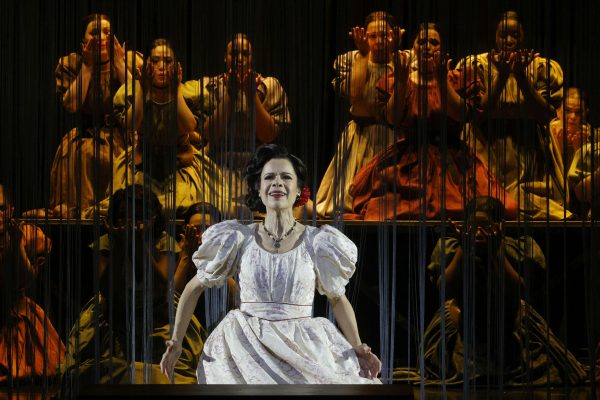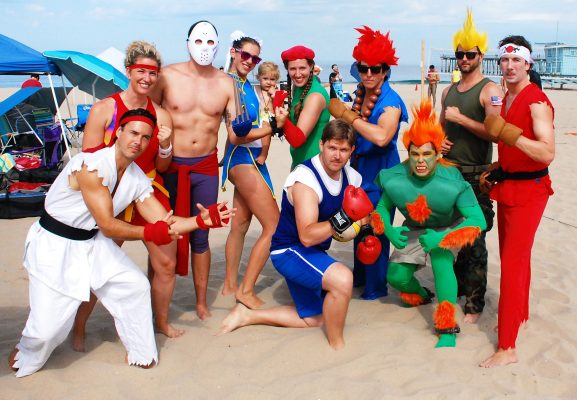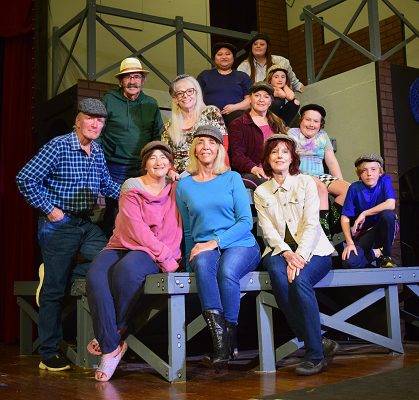by James Westhoff
I’m on my bike, slowly climbing up Palos Verdes Drive East towards the radar domes. It’s 8 a.m. and already very hot. I have an audiobook playing on my external speaker – American Prometheus: The Triumph and Tragedy of J. Robert Oppenheimer. It’s not exactly “Eye of the Tiger,” but I’m riveted. Like a lot of people these days, I’m having an Oppenheimer moment. There’s the excellent Christopher Nolan film, this Pulitzer Prize winning book — which is the basis of the film, and last year’s twin Cormac McCarthy novels The Passenger and Stella Maris, which deal heavily with the topics of physics, the Manhattan Project, and the implications of The Bomb.
In Stella Maris, McCarthy’s character Alicia Western tells her therapist: “Anyone who doesn’t understand that the Manhattan Project is one of the most significant events in human history hasn’t been paying attention. It’s up there with fire and language. It’s at least number three and it may be number one. We just don’t know yet. But we will.”
It’s not exactly what I had planned for the summer, this Oppenheimer Moment. But here it is.
The bike lane is virtually non-existent. Every truck that passes me has a lawn mower in it. In my heat exhaustion, I have trouble keeping a clear train of thought. Keep pedaling…Oppenheimer had a daughter he tried to give away…Oppenheimer taught at Berkeley…Oppenheimer was a physics teacher…
Wait.
I almost stop pedaling. A memory begins to uncoil itself. I start to yank at it with two hands, like I’m pulling an endless procession of colored scarves from a magician’s top hat. I stop my book. I turn off the speaker
The memory – the story – is hard to believe. It’s so absurd I must have sunk it deep in the permafrosts of my aging brain. But this confluence of circumstances, this Oppenheimer moment, has brought it back to me. I let it sublimate into my overheated skull.
This happened.
Did this happen?

It’s 1993 and I’m a senior at Campolindo High School in Moraga, California, just over the hills from Berkeley. I’m in an honors Physics class and my teacher is Tony de Bellis.
Tony de Bellis is a legend at Campo. He is easily the most interesting adult on campus, the subject of equal parts ridicule and awe. He is at times too absurd to take seriously, or too real to ignore. He is that teacher. Everyone’s had that teacher. He doesn’t really have a curriculum. He does his own thing. He designs his own experiments. He talks to us. He’s funny. He curses. The classroom isn’t arranged in rows of desks, but is a collection of lab stations. It’s an informal atmosphere, free-wheeling and unpredictable. You never know what’s going to happen in de Bellis’ class, though you can count on generous helpings of liberal politics, tirades against The Man, and paranoia about the dangers of the modern world. De Bellis is a pacifist, an environmentalist, and a bit of a luddite. And he is also, like Oppenheimer, a physicist.
One day we learn about gravity. De Bellis has this home-made device. It’s a two-foot horizontal tube of PVC pipe with a simple wire circuit covering one side. Next to this tube is another short horizontal section of PVC with a small ball suspended by a magnet. Another small ball is loaded into the horizontal tube. “I need someone with powerful lungs,” de Bellis tells us. “How about a soccer player?” I raise my hand. I step up to the device. I blow on the horizontal tube. The ball accelerates and exits, breaking the circuit. The magnet releases the second ball. Two balls in the air, one moving horizontal, the other moving vertical. They both impact the ground at the exact same time. Gravity. Vertical and horizontal forces don’t play with each other.
I have been taught something. I have seen the world act according to the proscribed laws of the universe. I will remember this lesson forever, it seems.
De Bellis’ favorite device is his EMF Meter. He measures everything. He measures students as they walk into class. And microwave ovens, telephones, computer screens, TV’s, power lines. He loves to report his findings and tell us stories about clashing with local government officials concerning unsafe conditions in the community. He is, as we all know, a huge pain in the ass. He is convinced our technology is killing us. He tells us if we ever need an immediate police response, tell 911 there’s a transformer on an electrical pole that’s dripping blue liquid.
Sometimes he sounds like a lunatic, a burned-out hippie idealist, an anachronism. Plenty of laughs are had at his expense. Everyone has their de Bellis impression. He’s Doc Brown (from Back to the Future) without the crazy hair. He has a doll in class named Gaia that he holds to his ear. It gives him spiritual wisdom, which he then imparts to us.
He’s not a lunatic, though. Not at all. He is, in fact, a very serious person, who has done remarkable things. In 1970, along with the Campolindo Physics Club, he built an electric motorcycle and competed in the Clean Air Car Race, driving from MIT to Cal Tech. They were the only high school team in the competition. Shortly after that, he and his students won the Innovation Award at the North American Urban Vehicle Design Competition with an electric car they had designed and built on the high school campus.
He is still driving that car in 1993. It’s parked in the faculty lot. It does not look like a Tesla. It’s a station wagon with wood paneling.
He also built a functional aluminum recycling plant next to the baseball diamond. It’s no longer working in 1993, but it’s there as a sort of monument to de Bellis’ hands-on commitment to his environmentalist agenda.
Midway through the school year there suddenly appear 10 brand new Commodore computers at the back of the classroom. They have been purchased with a grant of some sort. De Bellis has somehow channeled thousands of dollars worth of state-of-the-art technology into our classroom (in 1993!) We use the computers once, and then never again.
At his core, de Bellis is a pacifist. Later in life, he will be a member of the Mount Diablo Peace Center, whose vision is “a world community with peace, justice, and freedom for all. It is a revolutionary vision of a beloved community where differences are respected, conflicts are addressed nonviolently, oppressive structures are dismantled, and people live in harmony with the earth.”
In his physics class, we talk about war. There’s a lot of physics in war. Things get dropped. Things get shot into the air. And enriched uranium goes supercritical. De Bellis hated the atom bomb, likely because it exploited his beloved physics in the service of mass murder.
A few doors down, in U.S. History, we are learning about World War II. But it’s mostly about the Nazis and yellow stars – Hitler, Anne Frank, and the camps. Not much about the war with Japan, or Hiroshima and Nagasaki. Not much about the Manhattan Project – Los Alamos, Oppenheimer, and the gadget.
De Bellis, fortunately, is here to fill in the gaps. You live in a world under constant threat of obliteration. The Powers that Be have stolen fire from Mount Olympus. Mankind is at a critical juncture. He blames the hubris of his fellow scientists, the belief that all science is good science. Necessary science. Oppenheimer and the others at Los Alamos realized their folly almost instantly after the bombs were dropped. How could they have ignored the implications of their efforts? Why didn’t they stop themselves?
He is fixated on Oppenheimer, who lived locally, who taught locally. Shiva the Destroyer, who should have known better. De Bellis is mad. It’s real-world anger. You are kids. You deserve to live in a world at peace, in harmony with nature. It’s moments like this that de Bellis is real. He’s not a teacher at this point; he is a mentor. He is wise.
And then, one day in the spring of 1993, Tony de Bellis has a heart attack.
We come to class and he isn’t there. We hear about the heart attack. He’s in the hospital in stable condition. This too makes him real. As students, we often forget this about our teachers. There’s an unreality to seeing a teacher outside of school, living a life. I know. I grew up to become a teacher. I recently ran into a group of my own middle school students at Magic Mountain. They had trouble speaking to me. They pointed at my daughter as if she were a phantom. “Is that…is that…your daughter?”
I’ve made it to the top of San Pedro Hill. I stop in the shade below the radar domes – Ground Equipment Facility J-31, which coincidentally dates back to the Cold War. I’m working on my own heart attack. I drink my water. I try to clean the sunscreen and sweat streaks from my sunglasses but everything at hand is damp. I look down at the Port of Los Angeles and all that industry below me. The columns of steam. The maze of docks and piers and gantry cranes. A human world very much not in harmony with nature. I’m in full de Bellis mode. Must we have poor people who drive miles up steep hills to mow rich people’s lawns? It shouldn’t be this hot.
Hey, Oppie, is it all about to blow up?

Our substitute teacher is Mr. Ybarra. We call him Mr. Yeebarkee. He is easily 300 pounds. He never stops smiling. He’s a beloved pool sub we all know. When Mr. Yeebarkee is your teacher you know you’re not going to have to do shit. But on this day we motivate. We write letters to Mr. de Bellis. Get well soon. Hang in there. We love you. We tell him we will smuggle his EMF meter into the hospital so he can check things out.
And then the next day Mr. Ybarra is not there. Instead, we have a new sub. She’s a middle-aged woman and she’s written her name on the board in big white chalky letters:
Ms. Oppenheimer.
What do you mean, Ms. Oppenheimer?
“Yes, yes,” she tells us. “My grandfather…”
This is unbelievable. We tell her about de Bellis. We tell her everything and she wants to hear it all. “We know all about Oppenheimer,” we tell her. “I never met the man,” she tells us.
She’s our sub for several days. We try to get word to de Bellis through the office, but who knows if anything gets through. She’s a perfectly normal sub. A nice woman. We chat with her. We don’t talk about her grandfather. We learn, among other things, that this Ms. Oppenheimer is a hypnotist.
Bullshit, we think.
Prove it.
Ok, she says, I’m going to need a volunteer. And this is suddenly the best school day ever.
I don’t raise my hand. I don’t want to be hypnotized in front of my peers. What if she turns me into a duck or makes me take my pants off? There are plenty of volunteers though. A girl is chosen. She’s a friend of mine. Ms. Oppenheimer tells us she will put her to sleep.
Bullshit.
Is she about to bust out a pocket watch and start swinging it in front of this girl’s eyes, telling her in a thick German accent that she is getting very very sleepy?
Not quite. The girl is told to fold her arms on her table and put her head down. She is told to relax, to think about a special place. She describes this special place in great detail. The entire class is riveted, silent. The girl is told to go to sleep, and that she will wake up when she hears the word zero.
And then the girl is asleep. Her table-mate is asked to verify. She leans in close to monitor her soft breathing. We all hear low-volume snoring. She could be making this up. It could all have been pre-arranged. But we doubt that’s the case. After a minute we all count down from three. Three, two, one, zero! And the girl pops right up. She looks around, dazed. She wipes at the side of her mouth. She looks like someone who was just asleep.
The entire class applauds. Ms. Oppenheimer takes a bow.
The next day, class begins with a chant: “Again, again, again.”
This time Ms. O tells us she will hypnotize the entire class. This is apparently the new best day ever. Also, this has to be illegal.
We are all told to stand up. We all stand. “Extend your arm. Hold out your hand, palm up. Close your eyes.”
Here we are, an entire class of high school seniors — quiet, unquestioning, compliant. Standing at attention. Ready to follow orders. If de Bellis’ heart attack had been fatal, this would be the rolling-in-his-grave moment.
I am flying now, down Crest Road. The air wicks moisture from my body. I’m doing 40 mph. Did Oppenheimer’s granddaughter really hypnotize de Bellis’ honors physics class? I picture us all standing there, with our hands out, obedient, looking like a bunch of fascists.
“There is a ball in your hand,” she tells us. “Roll it around in your palm. Get a sense of its size and weight.” I open my eyes for a second to make sure I’m not the only asshole doing this. Everyone is doing it. “The ball is getting heavier.” I feel tension in my arm. Is it from holding my arm out over time, or is it the weight of the imaginary ball? “Heavier.” I feel my arm droop slightly. I try to raise it back to horizontal and I can’t. “Heavier. The sphere is growing.” My hand droops even lower. “Heavier still. You are holding a bowling ball.” I feel the bowling ball. I try to fight the pull of gravity. My arm starts to shake. I hear thudding hands on desks and gasps. I give up and let my own hand slam into my table. I open my eyes. I see some students are still fighting, eyes closed. “The ball will disappear in three, two, one, zero!” Those who were still fighting suddenly jerk their arms up and open their eyes. Everyone is looking around, amazed. I look at the girl who was put to sleep the previous day and kind of hope the word zero has put her back to sleep somehow. But no.
I’m standing there, rubbing my sore arm. I’ve been hypnotized by Oppenheimer’s granddaughter.
The next day Ms. O is gone. Mr. Yeebarkee is back. Oh, yeah, he tells us. I heard all about that. You’re not allowed to hypnotize your students. Parents called to complain.
Three weeks later, Mr. de Bellis is back. He has spent his entire recovery learning about what happened to his body. It is no longer a physics class. It is a health and nutrition class. He tells us what to eat, what to breathe, and how to stay fit. He tells us the mind and body are connected. He says you need to avoid stress. You need to set your mind at ease. He stands before us grateful for his health and recovery. He has learned the most valuable lesson of his life: how to stay alive. He is the peaceful Zen warrior.
“So,” he asks, looking out at the class. “What’d I miss?”
I whizz past Trump National. I’m pedaling hard even on the downhill. I need to get home. I need to look this up. Did Oppenheimer’s granddaughter really sub my class? Is that even possible? Her name was indeed Oppenheimer – you can’t give false names as a substitute teacher. She told us her grandfather was J. Robert.
But who was she?
At home I start to Google. Oppenheimer had two children, Peter and Toni. Toni had no children, but Peter had three: Dorothy, Charles, and Ella. Dorothy and Charles lead somewhat public lives. They give interviews and talk about their grandfather’s legacy. Ella lives a private life. She has a Facebook page with comments from Dorothy. She would have been middle-aged when I was in high school. The family has strong ties to the Bay Area.
What matters is that Mr. de Bellis was convinced.
I know first-hand the moment of terror you experience as a teacher when you put your hand on the knob to open your classroom door after a long absence. What lies on the other side? The burned-out ruins of your desk? 47 pencils embedded in the ceiling? Hot Cheetos wrappers wedged between books on the bookshelf. Who knows what de Bellis expected to find when he opened his door. What did he think when he saw the poorly erased Ms. Oppenheimer written on his chalkboard? And then, in the faculty cafeteria: “Welcome back, Tony. Did you hear Oppenheimer’s granddaughter hypnotized your honors physics class?” ER










